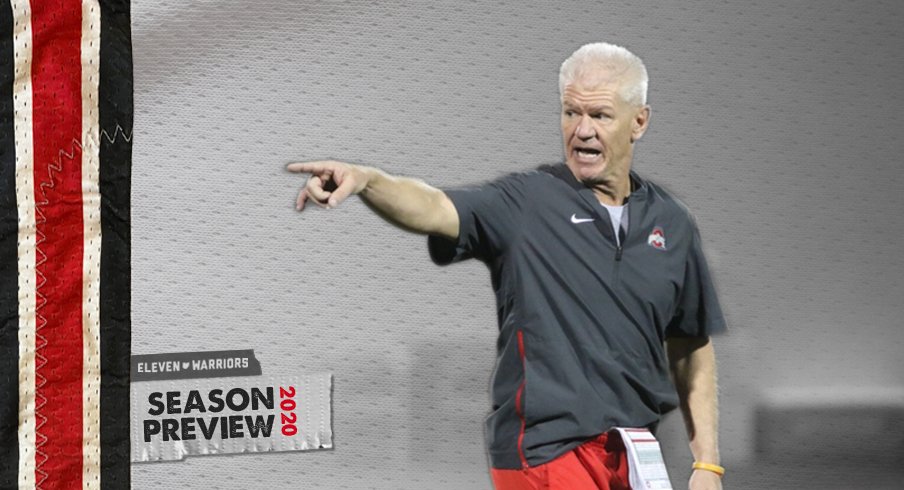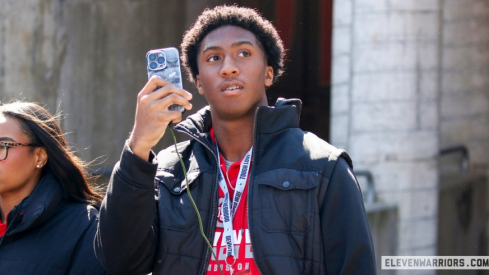Going into last season, Ohio State’s coaching staff suggested that the Buckeyes’ new defense would include a variety of packages and alignments that could change frequently. Instead, the Buckeyes ended up keeping their base defense on the field far more often than not.
That base defense, in a change from previous seasons, put three cornerbacks and one deep safety playing centerfield – instead of two cornerbacks and two safeties – along with two defensive ends, two defensive tackles and three linebackers.
While Ohio State continued to tease the possibility of also using two-safety packages, it rarely actually did so until the final game of the season against Clemson. The hybrid linebacker/safety “bullet” position that was expected to be a vehicle for Brendon White never became what it was hyped up to be, as starting Sam linebacker Pete Werner effectively ended up playing that role himself. The Buckeyes did introduce a four-linebacker package, which they used mostly against run-heavy teams like Wisconsin, but they rarely used the four-defensive end Rushmen package they had used more frequently in previous seasons.
There are multiple reasons why Ohio State chose to take a mostly singular approach to aligning its defense last year. For one, it worked: The Buckeyes led the nation with only 259.7 yards allowed per game and were fourth in the Football Bowl Subdivision with only 13.7 points allowed per game. The coaches talked about keeping their defense simple so their players could fly around the field, in contrast to 2018 when players were often out of position in Greg Schiano’s scheme, and the defense’s drastic improvement demonstrated the benefits of that approach.
But another reason why it made sense for Ohio State to commit to one defensive formation was because of the personnel it had last season. With three future first-round NFL cornerbacks in Jeff Okudah, Damon Arnette and Shaun Wade, Jeff Hafley didn’t want any of them to ever come off the field. Because Werner proved capable of lining up all over the field, even dropping back to play safety at times, the Buckeyes decided they’d rather keep him on the field over a second safety or a “bullet.” A deep and disruptive group of defensive tackles led by fifth-years DaVon Hamilton, Jashon Cornell and Robert Landers lessened the need to have a special pass-rushing package up front.
Going into this season, Ohio State’s coaches have said their base defense will not be changing from last season. While the Buckeyes have a new defensive coordinator in Kerry Coombs, he and other coaches have cited last year’s defensive success as a reason why they don’t need to make major changes to the scheme for 2020.
“We're really running the same defense,” safeties coach and special teams coordinator Matt Barnes said Wednesday. “We're really not a split-safety team. We dabbled with it here and there in the Clemson game, but even then it was mostly rotational … if it's not broke, don't fix it.”
Coombs has said, though, that he thinks it is important for the Buckeyes to have “the ability to play in multiple personnel groupings on defense.” And the fact that the Buckeyes don’t have the same personnel as last year, as they replace seven defensive starters from last season who are now in the NFL, could be reason enough for the Buckeyes to vary the look of their defense more regularly in 2020. Add in the potential for injuries and positive COVID-19 cases to impact which players Ohio State has available each week, and it could be necessary for the Buckeyes to have a more multiple defense this season if they’re going to match last year’s success.
“I think more than anything for us right now, it’s going to be ability-based,” Coombs said during a press conference last month. “It’s going to be based on the talent of the roster and frankly, the health of the roster. You’re gonna have to be flexible this year. You’re gonna have to be able to adapt to a lot of situations based on who’s healthy and able and ready to go. So those are things that may evolve more this year than any other.”
Last year, Ohio State had seven defensive players who played more than 500 snaps: Chase Young, Malik Harrison, Werner, Okudah, Arnette, Wade and Jordan Fuller. Each of them were almost always on the field with the first-team defense, while Tuf Borland and Baron Browning rotated at middle linebacker and several players rotated at the other three defensive line spots.
Wade and Werner will continue to be mainstays on the defense this year, but they’ll both be playing different roles, with Wade moving to outside cornerback and Werner moving to Will linebacker. And while it’s unlikely either of them will come off the field much, they could end up being the only every-down, every-series defensive players for the Buckeyes. Larry Johnson plans to deploy deep rotations at both defensive end and defensive tackle, Coombs has said he’ll rotate defensive backs and Al Washington wants to find roles for all seven of Ohio State’s upperclassman linebackers.
Also consider that the Buckeyes might have better depth at defensive end than defensive tackle and at safety than cornerback, and there’s a multitude of factors that could lead the Buckeyes to change up their defensive looks more in 2020 than they did in 2019.
The Single-High Base Defense
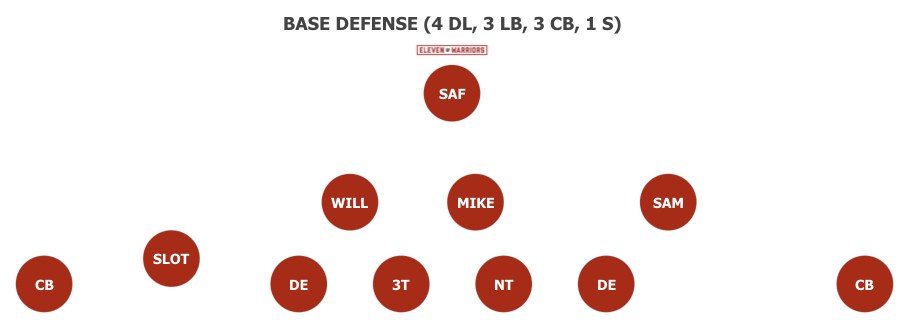
The single-high look was Ohio State’s bread-and-butter last season, and it turned out to be exactly what the Buckeyes needed schematically after their disastrous defensive season in 2018. Ohio State utilizes both Cover 1 (man) and Cover 3 (zone) coverages out of this alignment, and it presents the malleability for Ohio State to move players around to match up with opponents without needing to substitute players in and out of the lineup.
| DE | JONATHON COOPER/TYLER FRIDAY |
| DE | ZACH HARRISON/TYREKE SMITH/JAVONTAE JEAN-BAPTISTE |
| NT | TOMMY TOGIAI/JERRON CAGE |
| 3T | ANTWUAN JACKSON/TARON VINCENT/JADEN MCKENZIE |
| WILL | PETE WERNER/TERADJA MITCHELL |
| MIKE | TUF BORLAND/DALLAS GANT |
| SAM | BARON BROWNING/JUSTIN HILLIARD |
| CB | SHAUN WADE/TYREKE JOHNSON |
| CB | SEVYN BANKS/CAMERON BROWN |
| SLOT | MARCUS WILLIAMSON/RONNIE HICKMAN |
| SAF | MARCUS HOOKER/JOSH PROCTOR |
It’s a philosophy that Ryan Day and the Buckeyes’ four returning defensive assistant coaches believe in, and Coombs has said from the beginning that he is working with them to add to the scheme, not to replace it.
“There will be some coverage additions to what we do. But our base is going to be single-high defense,” Coombs said after he became defensive coordinator in February. “That's what we're going to play.”
Given that most college football teams now play with three wide receivers on the field at most if not all times, it makes sense for the Buckeyes to counter with three cornerbacks on the field, especially if they believe those cornerbacks can all be consistently trusted in man coverage.
The question now entering the 2020 season, after Ohio State had seven players drafted from last year’s defense, is whether their replacements can enable the Buckeyes to have the same level of success with this scheme. Now that Werner has moved to Will linebacker, can Browning or Justin Hilliard bring the same kind of versatility that he brought to the Sam position? Now that Wade has moved outside, can Marcus Williamson be relied upon as an every-down slot cornerback/cover safety like Wade was last year? Can Marcus Hooker or Josh Proctor be trusted to be the eraser at deep safety that Fuller was last season?
If the answer to any of those questions is no, the Buckeyes might be forced to substitute into subpackages more often, particularly in situations where the opponent is likely to pass.
Potential Two-Safety and Bullet Packages: The Same Thing?
While it’s still unclear whether the Buckeyes’ starting deep safety will be Hooker, Proctor or a rotation of both, Ohio State has indicated it expects both of them to be on the field together in some two-safety packages.
“We can come up with packages where they both will be out there, and they should be,” Day said. “They’re guys who have now been in the program for multiple years, and this is their year to step up. I think they’ve both done a very good job. They both bring different skill sets.”
What exactly those packages will look like, or how frequently the Buckeyes will utilize them, remains uncertain. There could be multiple. One look that both Day and Barnes have hinted at, though, is one that would play Hooker deep and Proctor as a box safety, which could effectively make Proctor the “bullet” that many thought White would be last season. By substituting Proctor in for a linebacker, the Buckeyes could have an extra defensive back on the field but still line up with seven defenders in the box as needed.
In that package, it’s likely the Sam linebacker would come off the field to be replaced by the Bullet/second safety, though someone like Browning could move back to Mike linebacker to play alongside Werner in that scenario.
“Probably everybody would say, 'What's the difference between Pete Werner and Josh Proctor?' You gain a little bit more with Pete in the run game than you would with Josh. You probably gain a little bit more in the throw game with Josh than you would with Pete,” Barnes said. “So some of those things will be situational and based on the offensive personnel that's on the field and what we think we're going to get at that time.”
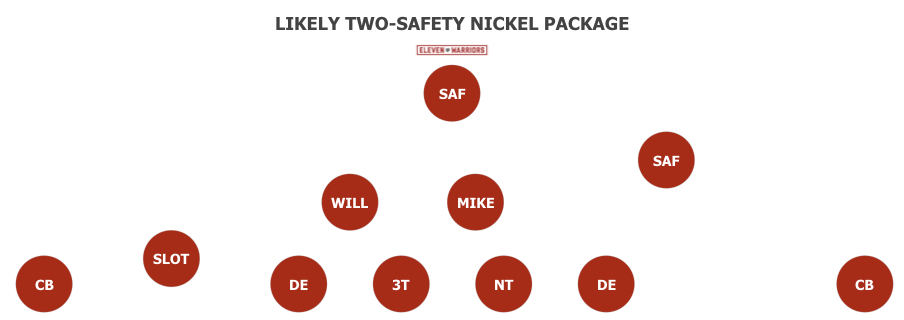
If Ohio State’s coaches are to be taken at their word – which is all we have right now, given that the first day of spring practice was the only time even us beat reporters have seen Ohio State line up in a defensive formation this offseason – then we aren’t likely to see the Buckeyes line up with two deep safeties on a regular basis.
But there could be some circumstances where that makes sense, particularly if Hooker and Proctor aren’t able to provide the same consistency as a single-high safety on the back end that Fuller did. Or conversely, if both of them and three linebackers establish themselves as two of Ohio State’s 11 best defenders, it could make sense to have both of them on the field with just two cornerbacks in a more traditional 4-3 in early-down situations.
Against spread-option teams like their season-opening opponent Nebraska and Clemson, the team that could stand in the way of their national championship hopes once again if they make the College Football Playoff, there could be additional value in putting a second safety on the field.
Return of the Rushmen?
With five defensive ends who Johnson considers to all be starting-caliber players – Jonathon Cooper, Zach Harrison, Tyreke Smith, Tyler Friday and Javontae Jean-Baptiste – and no established pass-rushing threat at defensive tackle, it seems likely we will see an all-defensive end front in pass-rushing situations more frequently than we did last season.
Johnson didn’t want to give away his specific plans in regards to who would be moving inside – though Friday seems like one likely candidate – when he spoke with the media last week, but he did suggest that we are likely to see a return of the Rushmen package on passing downs.
“We always want to have our best pass-rushers on the field in third-down situations, so we’re always going to transition to that,” Johnson said. “So yes, we’re working guys that I feel have a chance to really do something with the 3-technique if we need to change to rush the passer. So that’s always going to be part of our plan going forward, we just don’t know who’s going to emerge as that guy right now.
“I would say this: Between Javontae Baptiste and Tyler Friday and Cooper and Zach, you really have a good chance to do a lot of things with those five guys.”
Typically, Ohio State’s Rushmen front has been paired with a nickel or dime defense that either puts five or six defensive backs on the field. One variation could be pairing the Rushmen front with the two-linebacker, three-cornerback, two-safety look diagrammed above.
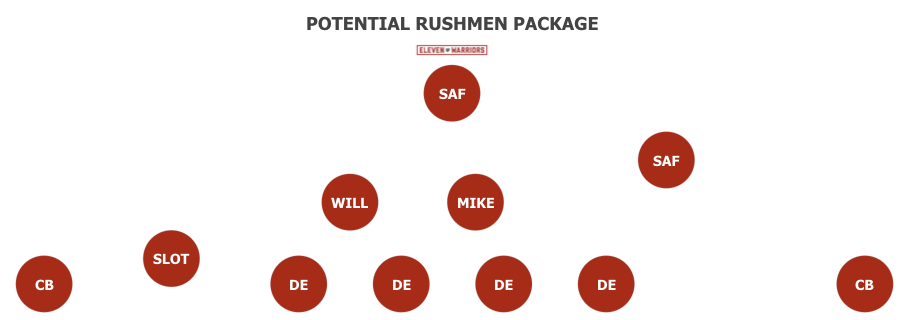
If the Buckeyes decide to truly unleash Browning as a pass-rusher this year, another possible variant could be a package that puts Browning on the line as a standup edge rusher with either three or four defensive linemen and one or two linebackers, giving the Buckeyes another speed-rushing option off the edge who could also drop back into coverage as needed.
The Four-Linebacker Package
While the subpackages above mostly focus on pass defense concepts, it’s likely the Buckeyes will also have some specialty packages for defending the run, and with all the linebacker depth Ohio State has this season, the four-linebacker look it sometimes used last season probably isn’t going to go anywhere.
Last year, that package typically consisted of Malik Harrison and either Borland or Browning manning the two inside linebacker spots with Werner and Hilliard playing as the two outside linebackers. With Werner and Browning changing positions this year, it’s presumable this package this year could consist of Werner and Borland as the inside linebackers with Browning and Hilliard as the outside linebackers, though this package could also be an opportunity to get one or two of the junior linebackers – Teradja Mitchell, Dallas Gant and K’Vaughan Pope – involved.
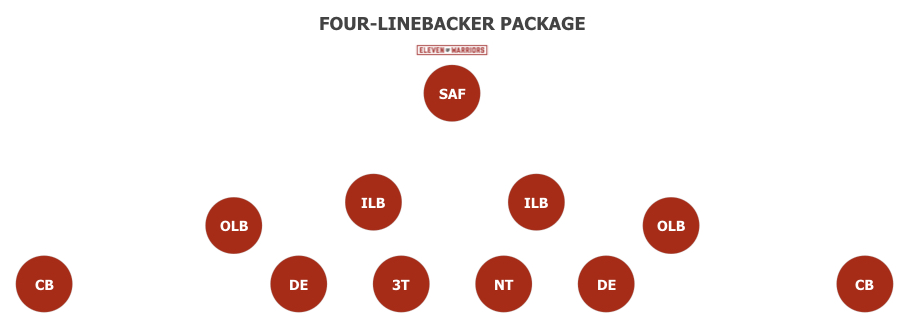
Matchups + Personnel = The Right Combination
Those are just a few of the different personnel groupings we’ve seen from the Buckeyes in the past and could see from Ohio State’s defense this year, and with an extra two months to prepare for the 2020 season – including several months during the spring and summer where Ohio State wasn’t able to practice and the coaches had more time than ever to scheme up plays – it’s likely they have some new packages and alignments in their back pocket that nobody outside the Woody Hayes Athletic Center knows about yet.
Even with the personnel groupings noted and diagrammed above, there are many different ways the Buckeyes can shift players around and create different looks without substituting players out of the game, which was a big part of what they did defensively in 2019 and will surely continue to be in 2020.
All of it will ultimately come down to getting the best 11 players on the field to defend against whatever Ohio State believes the opposing offense will try to do. And because the Buckeyes have a wide variety of talented defensive players with different skill sets, there are no shortage of possible lineups and formations they can put together to try to match up as best as possible with their opponent each week.
“We have guys with a variety of different skill sets, so we can match up better, we can get guys roles and we can contain guys in the sense of guys aren’t getting worn down,” Washington said. “I think we can do all of that while playing great defense. So that is exactly what we would like to do and what we are planning and working toward.”
The Buckeyes have to balance finding the right matchups and keeping players fresh with keeping their best players on the field and not making things too complicated. But in a year where they have to be prepared for potentially unforeseen challenges, their ability to adapt to different looks could be pivotal to their defensive success.
“It’s hard to not think about matchups, because that’s football. It’s all about matchups,” Washington said. “It’s all about, especially on the defensive side, it’s all about putting your players in position to do what they do best.”
